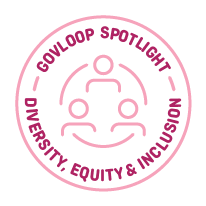 By Nina Bianchi
By Nina Bianchi
In recent months, there’s been a massive push toward equity in government with the White House issuing executive orders (EOs) and supporting policy guidance to help agencies advance equity.
For those looking to lead with equity in mind, the following is a top-level summary of our interpretation of the White House’s guidance on equity. We believe that government’s future rests on transforming three core experiences:
- How we work
- How we serve
- How we rebuild trust
Listen harder and put people at the center
Our government must deliver services and support in a way that is equitable for all. In practice, that includes:
- Evaluating the experience of public service delivery for those who have been historically marginalized.
- Ensuring that all people have a voice. When we don’t listen hard or often enough, we perpetuate public services developed with too few inputs.
According to the White House guidance, agencies must prioritize “investment in the expertise, capacity, and capabilities needed to engage stakeholders meaningfully” in their strategic planning.
The report adds that to include “the broadest representation of community voices,” agencies must expand upon their stakeholder engagement initiatives, particularly engaging stakeholder communities on experiences and concerns central to their communities.
Learn news ways of working
When leaders invest in customer and employee experience, it’s a significant step toward closing the equity gap. Designing Democracy 2.0 is no easy feat. The White House report advises that “advancing equity requires long-term change management, attention to culture, and a dedicated strategy for sustainability.”
Achieving more equitable government practices requires:
- Learning new ways of working.
- Learning to use new tools and strategies that access the voice of all people on a more regular basis.
- Embracing more accessible communication tools and data visualization to help show improvements.
It’s all about putting the walk to the talk. The “talk” can begin with having more focus groups within both government workforces and the public. Adopting technology tools that help us listen more often and review insights in real time to inform immediate action is another integral ingredient. Democracy 2.0 needs modern tools that enable organizations. The goal is to connect the dots between existing and newly created data to find the clear themes that marginalized communities are already communicating about their interactions with a given agency.
Create and deliver public service experiences
Government experiences are not transactions but engagements and relationships. New customer experience guidance from the Office of Management and Budget (OMB) includes further information on how agencies can define the services they provide. The following elements are what work together to create a customer experience:
Occasion: A given interaction or situation
Offering: The “thing” someone might need to obtain or accomplish, or a product, good or value received
Channels: The interactive places or mechanisms through which an offering is delivered
Tools: The technology required to provide a given experience
Roles: The tasks people perform across the stakeholder experience
As new stakeholder offerings are developed or existing offerings are refined over time, the White House explains that stakeholder engagement is a “critical resource for defining relevant problems and for crowdsourcing innovative solutions from those closest to the problem or opportunity.”
Stakeholder engagement experiences should inform how public offerings are designed – whether looking at it from an employee or customer experience point of view. Don’t forget that employee behavior is customer experience.
As enablement technology evolves, the government can invest in the expertise, capacity and capabilities needed to engage stakeholders more meaningfully. Insights gleaned through engagement experiences with advanced data analytic tools like machine learning can be pushed to data dashboards and translated with better leadership storytelling.
Rebuild and maintain trust
Democracy 2.0 holds the promise of more trust as agencies become more inclusive and participatory with all stakeholders involved.
Measuring experience factors regularly – and communicating progress to all interested parties – is the backbone of strengthening trust in public service. Other areas of focus to bridge equity gaps include:
- Managing performance data and making it easier for people to access this information to make better decisions faster.
- “Acquiring the necessary data either through the collection of new data or by blending information from multiple data sources, is a critical step in ensuring equity is a central component of decision-making processes across the federal government,” according to the Equitable Data Working Group created as part of the White House’s EO.
An adage states that “trust is earned by the drop and lost by the bucket.” The experience of evolving how we work, serve and rebuild trust in government may feel as if we’re attempting to move cultural mountains. Yet small steps will drive big change. Our mission is to improve people’s lives with publicly funded service experience. All leaders now have a clearer imperative to start this positive adventure together.
Interested in becoming a Featured Contributor? Email topics you’re interested in covering for GovLoop to [email protected]. And to read more from our summer/fall 2021 Cohort, here is a full list of every Featured Contributor during this cohort and a link to their stories.
Nina Bianchi focuses on transformative culture experiences. She served as Chief of People and Culture at the Food and Drug Administration (FDA) and with the General Services Administration’s (GSA) IT Modernization Centers of Excellence (COE). As a White House Presidential Innovation Fellow (PIF) with the Biden Cancer Moonshot at the National Cancer Institute (NCI), she led collaborative work experiences to drive personalized patient experiences. Before serving in government, Nina led a social innovation consulting firm with a network of high-impact public-private partnerships. Her teams designed transformation solutions for city governments across the globe, philanthropy, nonprofits, Fortune 500 companies and institutions like the Massachusetts Institute of Technology (MIT).






Leave a Reply
You must be logged in to post a comment.